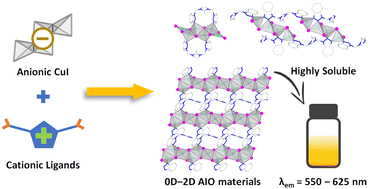Highly soluble copper(i) iodide-based hybrid luminescent semiconductors containing molecular and one-dimensional coordinated anionic inorganic motifs†
Abstract
Copper(I) iodide-based inorganic–organic hybrid semiconductors are considered promising materials for various optoelectronic applications. Here, using imidazolium bridged benzotriazoles as multidentate ligands, we designed and synthesized a series of all-in-one (AIO)-type CuI hybrid materials that hold both ionic and coordinate bonds at the interface of organic and inorganic modules. Their structures range from 0D clusters to 2D extended networks built on various molecular (0D) and chain-like (1D) anionic inorganic motifs that are interconnected through cationic ligands via multiple Cu–N bonds. Benefiting from their unique bonding nature, these compounds exhibit high stability towards heat and moisture and can be well dissolved in polar aprotic solvents. They emit low-energy light spanning from yellow to red color (550–625 nm). The electronic structure, emission mechanism, and effect of different coordination modes on their photophysical properties were studied using both experimental and theoretical methods, which has provided insight into the structure–property relationship of these inorganic–organic semiconductors.



 Please wait while we load your content...
Please wait while we load your content...
